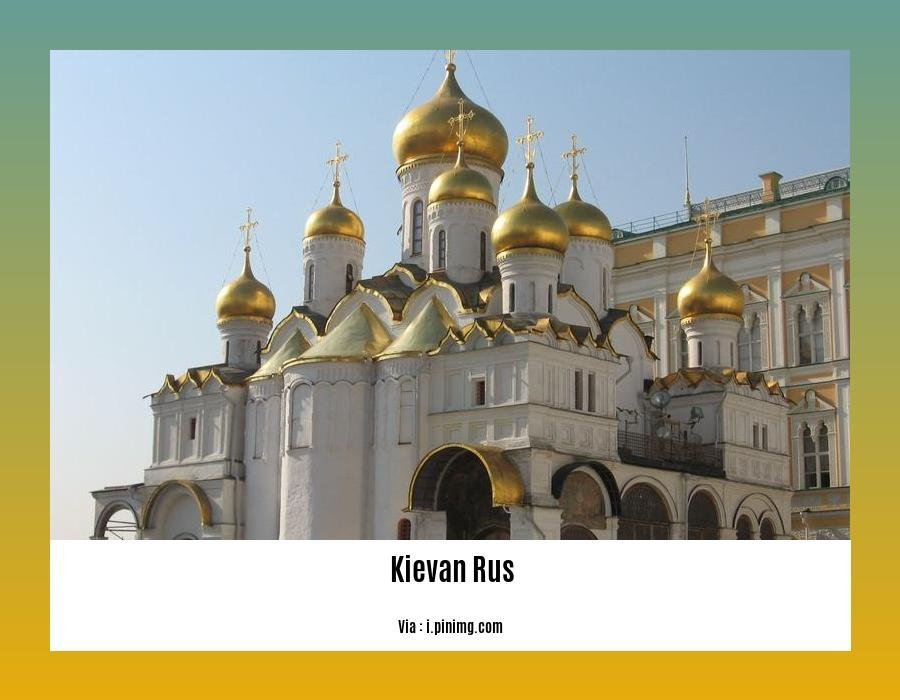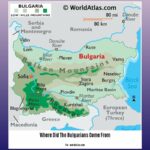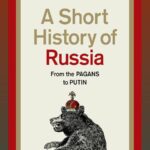Unveiling the Tapestry of Kievan Rus: A Journey into the Heart of Slavic Medieval Society. Prepare to embark on an enthralling journey as we delve into the captivating history, vibrant culture, and enduring legacy of Kievan Rus, a pivotal realm that shaped the destiny of Eastern Europe.
Key Takeaways:
- Kievan Rus’ emerged from the unification of East-Slavic lands, with the name “Rus'” likely originating from the Norse.
- It flourished as one of the largest European states of its time, known for its literacy, art, and architecture.
- The state’s complex relationships with neighboring steppe peoples, such as the Pechenegs, influenced its history.
- Its administrative structure comprised princely domains called “zemlias” or “volosts.”
- Kievan Rus’ played a pivotal role in the spread of Christianity and literacy across Eastern Europe, leaving an enduring legacy in the region’s history and culture.
Kievan Rus
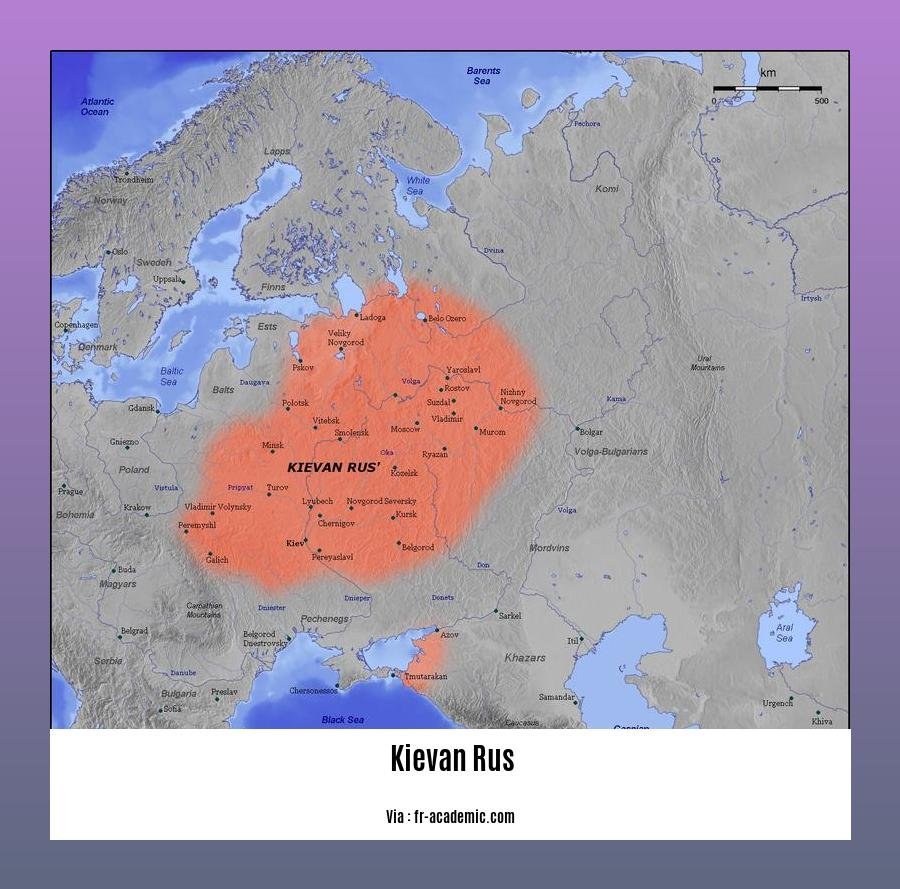
Imagine a vibrant tapestry woven with the threads of Slavic culture, Norse influence, and Byzantine grandeur. That tapestry is Kievan Rus, a medieval empire that spanned Eastern and Northern Europe from the late 9th to the mid-13th century.
At the heart of Kievan Rus lay a fusion of East Slavic tribes, united under the rule of the legendary Rurik dynasty. Their realm stretched from the Baltic Sea to the Black Sea, connecting the Nordic world with the Byzantine Empire.
Kievan Rus left an enduring legacy on the region:
Political Foundation: It established a centralized state structure that laid the groundwork for future Russian and Ukrainian nations.
Cultural Hub: Its cities became centers of art, literature, and architecture, fostering the development of Slavic culture.
Spread of Christianity: Missions sent by the Byzantine Empire converted Kievan Rus to Orthodox Christianity, shaping its religious and cultural identity.
Trade and Diplomacy: The state’s location at the crossroads of Europe and Asia facilitated extensive trade networks and diplomatic relations with neighboring powers.
Within Kievan Rus, life was a mosaic of diverse influences:
Vikings: Norse warriors and traders played a significant role in the state’s early history, influencing its political and military structures.
Byzantines: The Byzantine Empire’s cultural and religious influence left a lasting mark on art, architecture, and law.
Slavs: The core population of Kievan Rus was comprised of Slavic tribes, whose traditions and beliefs shaped its social and cultural fabric.
Kievan Rus‘s legacy continues to resonate today. Its traditions, values, and political structures have influenced the development of modern Russia, Ukraine, and other Eastern European nations. As we delve into the intricate tapestry of its history, we gain a deeper understanding of the roots of Slavic civilization and the enduring power of medieval empires.
Learn about the fascinating history of Ukraine, a land with a rich and storied past.
Discover the role of the Cossack Hetmanate in shaping Ukraine’s identity and the significance of Ukrainian independence in the modern world.
Religious and cultural influence
The religious and cultural influence on Kievan Rus was profound. The adoption of Christianity from the Byzantine Empire in 989 was a watershed moment. This brought Kievan Rus into the fold of Orthodox Christianity, which became the official religion of the state.
The religious and cultural influence of Byzantium was evident in many aspects of Kievan Rus society. Byzantine art, architecture, and music all left their mark on Kievan Rus culture. The construction of the Hagia Sophia in Kiev, modeled after the famous cathedral in Constantinople, is a testament to the Byzantine influence on Kievan Rus architecture.
The adoption of Christianity also had a profound impact on the social and political structure of Kievan Rus. The church played a central role in the governance of the state, and the clergy were often advisors to the князь (prince). The church also played a role in the education of the people, and monasteries became centers of learning and culture.
The religious and cultural influence of Byzantium was not the only influence on Kievan Rus. The state was also influenced by the Slavic, Norse, and Turkic cultures of the region. This blending of cultures created a unique and vibrant society that was both Eastern and Western in character.
Key Takeaways:
- Kievan Rus adopted Christianity from the Byzantine Empire in 989.
- The adoption of Christianity had a profound impact on Kievan Rus society.
- The religious and cultural influence of Byzantium was evident in many aspects of Kievan Rus culture.
- The religious and cultural influence of other cultures also played a role in shaping Kievan Rus society.
Citations:
Political Fragmentation and Decline
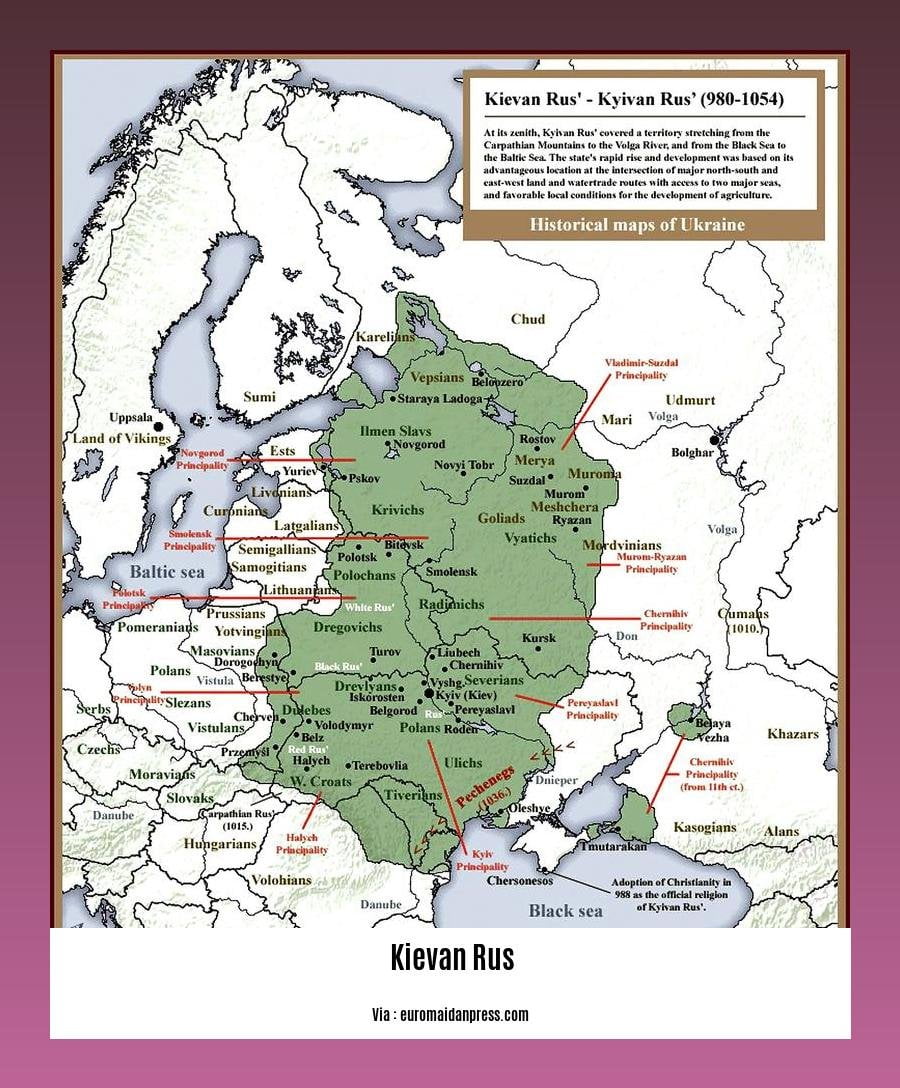
Kievan Rus’, a once-mighty realm, faced a slow but steady decline. Seeds of disintegration were sown within its vast expanse, gradually eroding its political unity and economic prosperity.
Factors Contributing to Fragmentation
- Succession Disputes: The absence of a clear and established succession system led to power struggles among the Rurikid princes.
- Growing Influence of Local Elites: As trade and commerce flourished, regional boyars (nobles) gained power and sought greater autonomy.
- External Invasions: Constant raids by nomadic tribes, such as the Pechenegs and Cumans, weakened the central authority’s control.
Consequences of Fragmentation
- Decline of Central Authority: The fragmentation weakened the central government in Kiev, making it difficult to maintain control over the far-flung territories.
- Princely Rivalries: Rivalries between the Rurikid princes intensified, leading to internal conflicts and civil wars.
- Economic Decline: The disruption of trade routes and the loss of centralized control over resources led to economic decline.
Table: Princely Divisions of Kievan Rus
| Principality | Year of Separation |
|---|---|
| Novgorod | 1136 |
| Vladimir-Suzdal | 1169 |
| Galicia-Volhynia | 1199 |
| Tver | 1247 |
Key Takeaways:
- Political fragmentation was influenced by succession disputes, growing power of local elites, and external invasions.
- Fragmentation weakened central authority, fueled princely rivalries, and led to economic decline.
- The division of Kievan Rus into smaller principalities became a defining characteristic of its post-peak period.
Relevant URL Sources:
Legacy and impact of Kievan Rus
The Legacy and impact of Kievan Rus reverberates throughout Eastern Europe to this day, leaving an indelible mark on the cultural, political, and social fabric of the region. As a crucible of Slavic civilization, Kievan Rus laid the foundation for the emergence of modern Russia, Ukraine, and Belarus. Embark on a journey through the profound legacy of this enigmatic medieval realm.
Cultural Heritage
Kievan Rus disseminated the Cyrillic alphabet, a cultural linchpin that unlocked literacy and literary expression across Slavic lands. The chronicles, religious texts, and works of literature produced during this period laid the groundwork for future Slavic cultural and intellectual achievements.
Political Legacy
Kievan Rus forged a centralized state that unified disparate Slavic tribes and became a model for subsequent Russian polities. The Rurik dynasty, which ruled for over three centuries, established a system of governance that influenced political developments in Eastern Europe for centuries.
Religious Influence
The adoption of Orthodox Christianity from Byzantium in 988 was a pivotal event in Kievan Rus history. It bound the realm to the Byzantine cultural sphere and introduced a unifying spiritual force that shaped religious practices and beliefs. The construction of monumental cathedrals, such as Saint Sophia Cathedral in Kyiv, showcased the artistic and architectural brilliance of Kievan Rus.
Economic Impact
Kievan Rus occupied a strategic position along major trade routes, connecting Scandinavia with the Byzantine Empire and the Caspian Sea. This facilitated a thriving trade network that brought wealth and prosperity to the region. The establishment of trade centers and the minting of currency further stimulated economic growth.
Social Transformation
Kievan Rus witnessed a complex social hierarchy with boyars (nobles), warriors, clergy, and peasants forming distinct classes. The development of cities, such as Kyiv and Novgorod, fostered intellectual and cultural exchange, leading to the emergence of a vibrant urban society.
Key Takeaways:
- Codification of Slavic language and literature through the Cyrillic alphabet
- Establishment of a centralized state model under the Rurik dynasty
- Adoption of Orthodox Christianity and its profound cultural impact
- Strategic location facilitating trade and economic prosperity
- Creation of a complex social hierarchy and the rise of urban centers
Sources:
- Kievan Rus’ – Encyclopedia Britannica
- Kievan Rus’: A Historical Perspective
FAQ
Q1: When was Kievan Rus’ established and how long did it last?
A1: Kievan Rus’ emerged in the late 9th century and lasted until the mid-13th century.
Q2: What was the origin of the name “Kievan Rus'”?
A2: The name “Rus'” may originate from the ethnonym “Rusĭ,” possibly related to Norse terms for rowing or Sweden.
Q3:What were the key factors that contributed to the rise of Kievan Rus’?
A3: The unification of East Slavic lands, the adoption of Christianity, and the development of trade and commerce played significant roles in the rise of Kievan Rus’.
Q4: How did Kievan Rus’ influence the cultural development of Eastern Europe?
A4: Kievan Rus’ was a highly literate state with advanced arts and architecture. It played a crucial role in spreading Christianity and literacy across Eastern Europe.
Q5: What were the major challenges faced by Kievan Rus’ during its existence?
A5: Kievan Rus’ faced challenges such as nomadic invasions, internal conflicts, and the Mongol invasion, which ultimately led to its decline and fragmentation.
